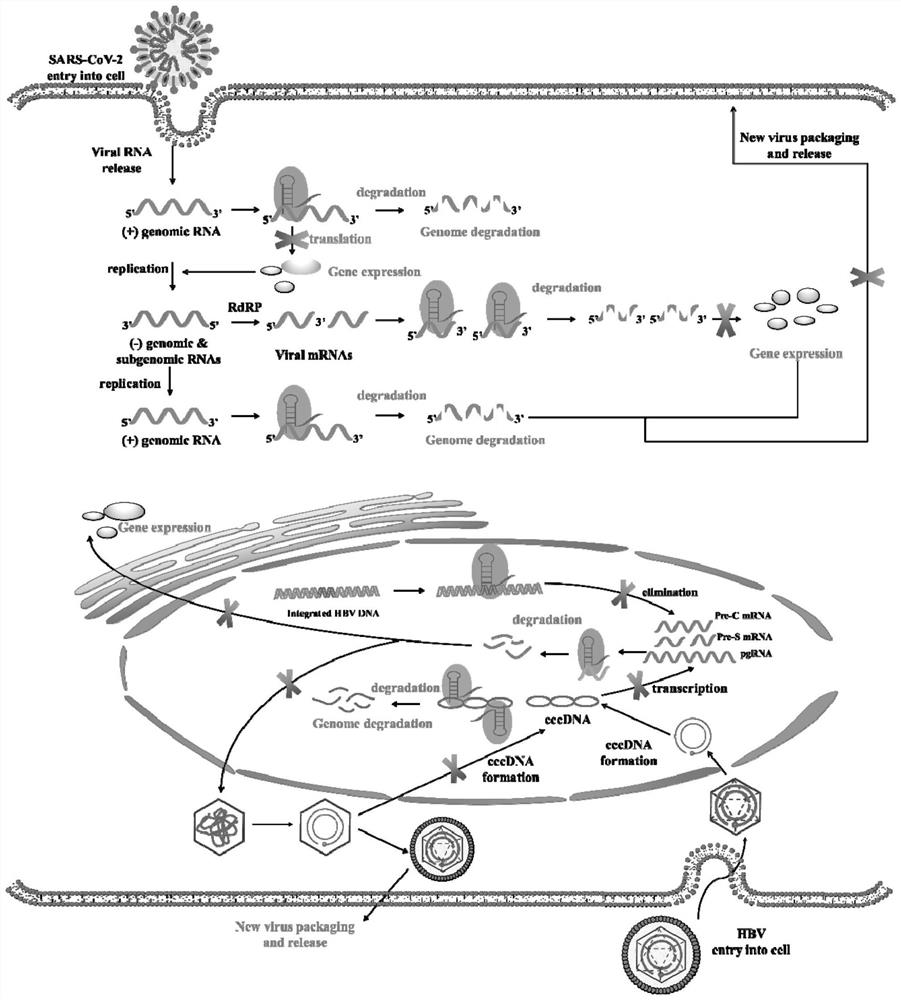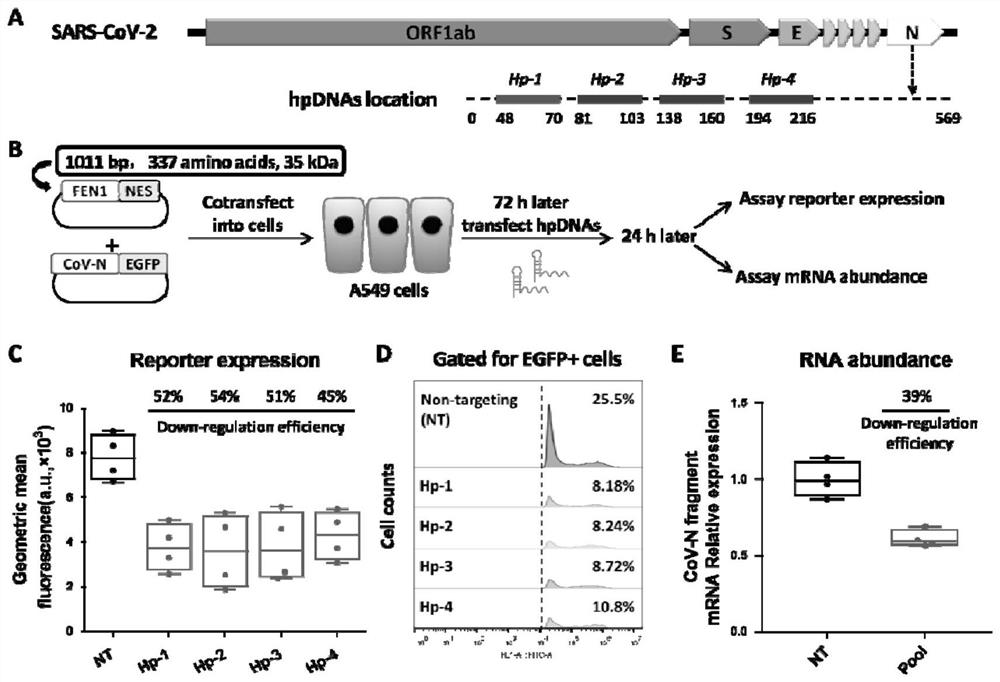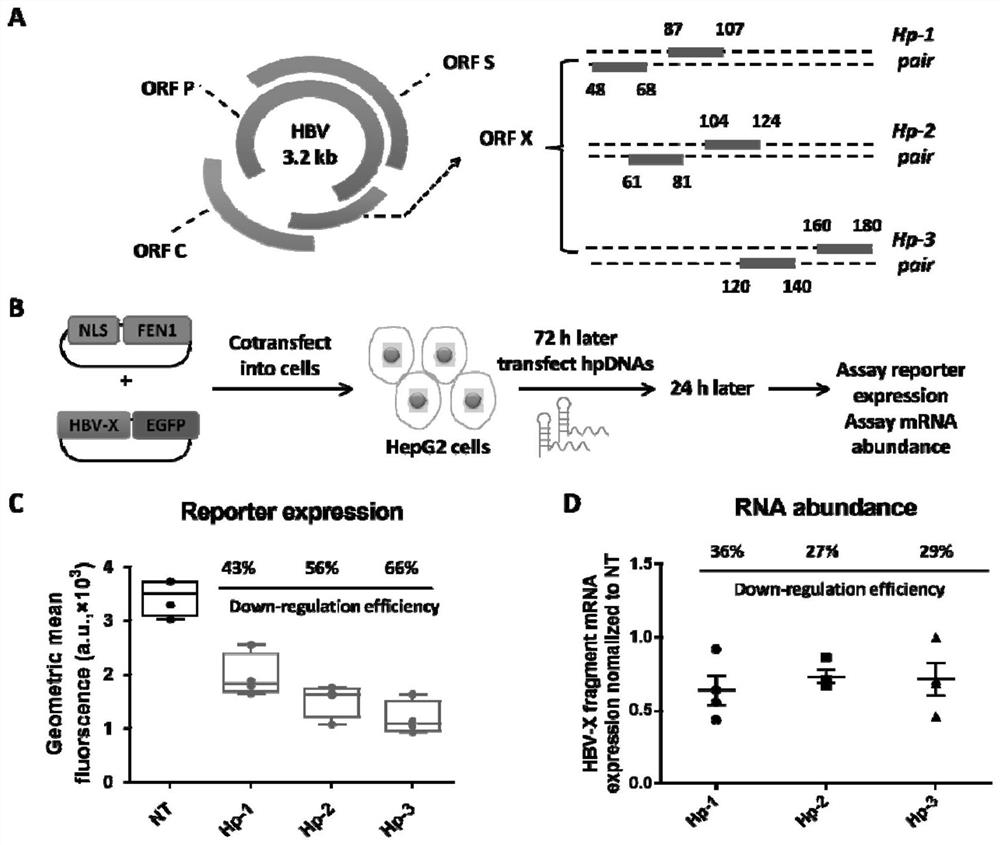Medicine capable of simultaneously targeting RNA (Ribonucleic Acid) and DNA (Deoxyribonucleic Acid) viruses and application
A drug and virus technology, applied in the field of biomedicine, to achieve the effect of small molecular weight, simple synthesis, small economy and time cost
- Summary
- Abstract
- Description
- Claims
- Application Information
AI Technical Summary
Problems solved by technology
Method used
Image
Examples
Embodiment 1
[0056] Example 1 AntiV-SGN can inhibit the expression level of SARS-CoV-2 reporter plasmid in mammalian cells
[0057] The ssRNA genome of the RNA virus SARS-CoV-2 is 30,000-nt and contains 12 coding functional open reading frames. According to previous studies, the end of its genome is the nucleocapsid protein (N) gene, which is a highly conserved region that encodes the capsid protein for viral packaging. Since our AntiV-SGN system has no target sequence restriction (such as PAM / PFS), theoretically any position in the N gene can be a candidate position of hpDNA. We ruled out leader sequences that might bind in the human transcriptome, designed and synthesized four hpDNA targeting N genes as figure 2 - A (Hp-CoV-1, Hp-CoV-2, Hp-CoV-3, Hp-CoV-4).
[0058] In order to verify whether AntiV-SGN (nucleotide sequence as shown in SEQ ID NO.1, encoded amino acid sequence as shown in SEQID NO.2) can successfully inhibit RNA virus SARS-CoV-2 reporter plasmid in mammalian cells For ...
Embodiment 2
[0070] Example 2 AntiV-SGN can inhibit the expression level of HBV reporter plasmid in mammalian cells
[0071] In order to verify whether AntiV-SGN can successfully inhibit the expression of DNA virus HBV reporter plasmid in mammalian cells, we synthesized a gene encoding A. fulgidus FEN1 protein (1011bp, 336 amino acids, 35kDa) and linked An NLS for optimal expression in the nucleus NLS-FEN1 plasmid [1] .
[0072] Then construct the HBV reporter plasmid, first use restriction endonuclease HindIII and KpnI to carry out digestion, pEGFP-N1 plasmid is linearized, secondly obtain the DNA fragment containing X protein sequence by PCR amplification and use restriction endonuclease HindIII and KpnI KpnI was digested to obtain DNA fragments with cohesive ends (primers were HBx-F-HindIII and HBx-R-KpnI, respectively), and finally the linearized vector was enzyme-ligated with the DNA fragment containing the X protein sequence by T4 DNA ligase to obtain HBV reporter plasmid (the targ...
Embodiment 3
[0077] Example 3 Comparison of AntiV-SGN with existing gene editing tools RNAi and CRISPR
[0078] Both CRISPR system and RNAi are widely used in gene editing technology. Among them, the CRISPR system has always had the problem of inconvenient delivery in vivo due to the relatively large size of the Cas protein (1367 amino acids to 422 amino acids). Although some recent studies have reported that RNA-targeting Cas9 (RCas9) can be used to edit RNA, however, in specific In research, Cas9 is usually used to edit DNA viruses, and Cas13 is usually used to edit RNA viruses. While the AntiV-SGN system only needs to change the leader sequence (20-nt) of hpDNAs when targeting different subtypes of different viruses, it does not need to change the protein, making AntiV-SGN an ideal supplement to traditional antiviral drugs in low cost and time.
[0079] In order to prove the advantages of the AntiV-SGN system, we first compared its differences with CRISPR-Cas13 and siRNA in HEK293, A54...
PUM
 Login to View More
Login to View More Abstract
Description
Claims
Application Information
 Login to View More
Login to View More - R&D
- Intellectual Property
- Life Sciences
- Materials
- Tech Scout
- Unparalleled Data Quality
- Higher Quality Content
- 60% Fewer Hallucinations
Browse by: Latest US Patents, China's latest patents, Technical Efficacy Thesaurus, Application Domain, Technology Topic, Popular Technical Reports.
© 2025 PatSnap. All rights reserved.Legal|Privacy policy|Modern Slavery Act Transparency Statement|Sitemap|About US| Contact US: help@patsnap.com



